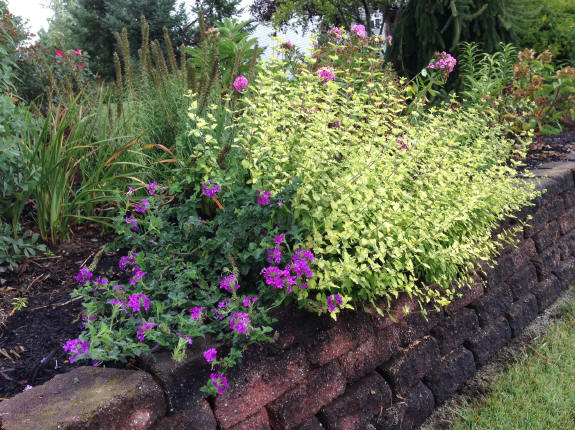Barbara Mrgich
Adams County Master Gardener

Caryopteris incana 'Jason' (Sunshine Blue) is often referred to as Blue Beard. It is a favorite shrub of anyone who grows it. Its bright yellow foliage brightens up the garden all summer, then in late summer it produces pretty blue flowers just when many other flowers have finished their show.
Caryopteris (cary-OP-ter-is) is not one of our native shrubs, but it attracts many pollinators, especially bees and butterflies. In the fall, when it is in flower, it will be buzzing with bees, so don't plant it right beside your front door. There are several other varieties of Caropteris to choose from. They are all lovely, but 'Sunshine Blue' is
the one I have loved for years.
This small, deciduous shrub will grow to be an airy two to three feet tall and wide, and will flourish in just about any average, well-drained garden soil. It needs full sunshine (at least six hours) to maintain its bright yellow foliage. It is hardy down to zone 5, which means it will tolerate any winter we will get here in South-Central
Pennsylvania. Cut it back hard in early spring for the best flowering. It will look like a little clump of dead sticks, but never fear, soon bright yellow leaves will appear on those dead-looking sticks, and before you know it, the shrub will be filled out to a nice size.
Many favorite perennials that brighten you garden in June and July are slow to start in the spring and then begin to decline sometime in August. Here is a garden plan to carry you through from early spring through fall.
Plant your Sunshine Blue Caryopteris shrubs along the front edge of your border. Fill the areas between them with spring-flowering bulbs, and overplant the bulbs with Verbena 'Homestead Purple'. Fill in the area behind the shrubs with some tall perennials such as garden phlox and Monarda (Bee Balm) which may tend to get "unattractive ankles" that
will now be camouflaged by the bright yellow foliage of the Caryopteris. Be sure to keep them at least two feet back. You don't want the perennials growing up through the shrub.

Other suggestions for tall perennials might be Coneflowers, Day lilies, Liatris, Agastache, and Milkweed (for the monarch butterflies). Add some Solidago 'Fireworks' and some purple Asters for fall color.
The bulbs will bloom in the early spring, while the Blue Beard is still sticks, and the verbena is just starting to sprout leaves. When the bulbs finish, the Blue Beard will have started to fill out, and the new bright yellow foliage will help to hide the declining bulb leaves. The verbena produces dark purple flowers which grow as a ground cover
and contrast beautifully with the yellow foliage of the Caryopteris all summer.
Near the end of the season as the perennials decline, the Caryopteris will begin to bloom, and steal the show. Cut the phlox, and daylilies down to the ground as they finish to neaten up your garden. Let the seed heads of the coneflowers, liatris, and Monarda stand for the birds. Agastache will have continuous bloom from July through frost.
A quick note about Tall Garden Phlox: Tall phlox will bloom with large, beautiful flower heads. When those flowers die, they will become a little unsightly for a while, as most flowers do. But if you have patience and leave them alone, you will soon see the buds of new flowers developing in the same old flower head. Mine tend to rebloom three times
in a summer. After the third time, I cut the whole plant off to the ground.
Likewise, daylilies will bloom, then tend to get ugly. Cut the entire plant off at ground level. Get rid of the ugly! It will fill back in with healthy green leaves which will look good until fall, and if it is a rebloomer, it will bloom again.
I use a lot of compost in my gardens that feeds the soil and seems to encourage everything, including the Caryopteris to reseed. Every year, I get a few babies. They are very easy to recognize because they are bright yellow. There are not so many to make it a problem, but just enough to easily get new plants if I want to add more, or give some
away. It will take that baby about two or three years to establish as a mature plant.
I tuck my plants in with the compost at the end of the season paying careful attention to the verbena which is famous for dying out over the winter. Even though one plant may have spread as far as five feet during the summer, I cut it back hard to within about a foot of each stem. Then I pile an extra helping of compost right up to and around it.
Read other articles on shrubs and vines
Read other articles on garden and landscape design
Read other articles by Barbara Mrgich